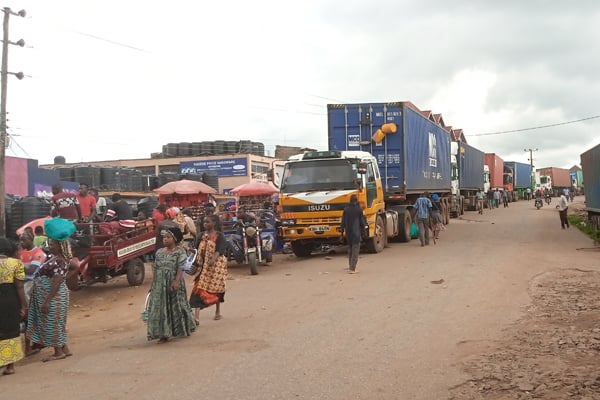Why the Uganda–DRC border remains porous

Business at the Uganda-DR Congo border post at Mpondwe in Kasese District. PHOTO/JOEL KAGUTA
What you need to know:
- Questions around the continued failure to secure the border Uganda shares with the Democratic Republic of the Congo this week increased after local militiamen killed two foreign tourists and their local guide in Kasese. In this explainer, Alex Ashaba and Moureen Biira offer answers as to why the border remains porous.
What does the state of affairs at the border look like?
The land boundary between Uganda and the Democratic Republic of the Congo (DRC) straddles 950km. The border is renowned for its porousness, not least in Kasese District that counts only one designated border point at Bwera. There are nearly six sub-counties on the border, with River Lhubiriha splitting the two countries.
The river that originates from Mountain Rwenzori stretches into Queen Elizabeth National Park on the Ugandan side and Virunga National Park on the Congolese side. Some of the sub-counties that dot the porous border include: Ihandiro, Isango, Karambi, Bwera, and Mpondwe-Lhubiriha Town Council, among others. Isango Sub-county, which neighbours River Lhubiriha with an estimated 30 to 40-kilometre stretch, has—per the Kasese district deputy RDC, Rtd Lt Maate Magwara—gained notoriety for its porousness.
Why can’t state actors police such areas better?
While the leadership of Ihandiro Sub-county in Bukonzo West County emphasise the dire need for the government to establish a police post in the area, Mr Magwara says “ it is not possible to put soldiers at all those porous borders.”
Because of this, Mr Obed Masereka, the District Councillor representing the people of Ihandiro, can list more than 10 porous border entries in their sub-county. These include: Kafalasi, Kaghombyo, Kyuna, Kasesa, Kasinga, Kibirigha, Kibati, Kyabihondo, Bulhambayiri, Bulemba, Busolhu, and Kyapa. Valleys along River Lhubiriha and Muruseghe, Mr Masereka opines, could serve as possible hideouts for rogue elements.
Is it true that locals in Kasese have popularised illegal border crossings that rogue elements nowadays use with absurd ease?
Yes. For years, many Kasese residents living near the Uganda-DRC border have gravitated toward illegal border crossings for various purposes. This includes farming, checking on their relatives, and attending markets. They prefer these crossings over the designated border point at Bwera because the latter levies crossing fees. In Kitholhu Sub-county, where agriculture is the backbone of many communities, six illegal border crossings, including Kasinga, Kisabu, Musangania, Kararo, Kahuha, and Kibati, continue to pose pain points in the terrorism fight. This is per Mr Emmanuel Kule Maliba, the area chairperson.
So are we looking at a lost cause here?
Not per state actors like Maj Gen Dick Olum, the UPDF Mountain Division Commander and Operation Shujaa pointsman in the eastern DRC. He emerged from a joint security meeting in Kasese on Thursday stronger than ever in his conviction that a telling blow will be landed on the ADF. The meeting was attended by Gen Christopher Ddamulira, the Director of Crime Intelligence; Col Saul Nabimanya Bishusha, Regional Police Commander; Col Allan Kyangungu, Commander of National Vital Assets and Strategic Installations; Johnson Kiconco, Rwenzori Regional Police Commander; Margaret Kasumba, manager of law enforcement, among others.
What about the tourism side of things?
Mr Sam Mwandha, the Uganda Wildlife Authority (UWA) executive director, is also sanguine. He said in collaboration with security agencies, UWA has taken swift comprehensive measures to enhance security within Queen Elizabeth National Park and its surrounding areas. Mr Mwandha also disclosed that a multi-pronged approach will take centre-stage forthwith. It will, he added, be aimed at safeguarding the park and its visitors, particularly in areas that are considered vulnerable to rebel attacks.
Mr Mwandha further revealed that tour companies operating within Queen Elizabeth National Park can now request security escorts for their guests. The UWA top honcho reassured the public that the security situation within Queen Elizabeth National Park, as well as other parks in Uganda, remains stable.
Why does it seem like the security presence in Kasese District’s hotspots leaves a lot to be desired?
Per Mr Masereka, the security architecture in the district is indeed wanting. The Ihandiro District Councillor told Sunday Monitor that the lone police post they had in the area ceased to exist when the government merged police posts in rural areas with larger police stations.
Consequently, Mr Masereka has urged the government to establish an army detachment in the Sub-county. He has also advised state actors to seriously consider deploying sufficient security personnel along the entire border, including river valleys, to minimise and monitor the entry of individuals.
Mr Moses Tsutsu, the chairperson of Isango Sub-county, agrees, adding that for now, they will have to augment community policing endeavours.
“Because of the attacks by suspected ADF rebels, we held a security meeting and resolved to start holding weekly village meetings with village chairpersons, and also ensure all people in their villages are registered,” Mr Tsutsu said.



